Abstract
Ulaanbaatar, the capital of Mongolia, is the coldest capital city in the world with limited available time for executing concrete works due to the cold climate. The cold season raises not only technical issues, but also socio-economic issues, for example, loss of production stability, and unemployment during the winter. Along with the development of modern concrete technology, the properties and advantages of concrete have been studied in many ways depending on cold climatic conditions. However, while inappropriate construction works during the winter season can be frequently observed in Mongolia, the background has not been fully investigated. In this study, the current situation of concrete works during winter in Mongolia and the standard specifications were investigated. In addition, a questionnaire survey of construction personnel was conducted. A questionnaire survey on cold weather concreting in Mongolia revealed that the current norms do not cover the requirements for planning, preparation, curing, and preventing methods from early age freezing; and quality control during the cold season. In total, 71% of respondents answered that they execute concrete works during the winter season, even ambient air temperature is between −10 and −20 °C. However, 53% of them thought that current Mongolian norms are not sufficient for the cold weather concreting.
1. Introduction
Mongolia is the second-largest landlocked country in the world with a total area of 1,566,500 km2. Ulaanbaatar (UB), the capital and the largest city, is home to about 45% of the country’s population. It has been recorded as the coldest capital city in the world, the average annual temperature in the city is −1.3 °C. The minimum temperature in January is as low as −36 to −40 °C. In most parts of Mongolia, the average temperature from November to March is below freezing and winter nights can drop to −40 °C [].
Due to the extremely cold weather conditions, the limited available time for executing concrete work has become a pressing issue for the development of the construction industry in Mongolia. The early age frost damage and slow gain in strength lead to later demolding times, which are the main problems related to cold weather concreting []. Many studies have been conducted for preventing concrete from frost damage [,]. The mechanical strength and hydration behavior of Portland cement and calcium sulfoaluminate cement mixtures have been investigated when exposed to different temperatures from −5 °C to −20 °C []. The curing time required for early-age concrete to prevent frost damage has also been investigated in several studies [,]. The heating, warming, and introduction of antifreezing admixtures have been investigated by several researchers as a remedy for cold weather concreting [,,,,]. Such kinds of available countermeasures against cold weather conditions often used in cold weather countries are not practical in Mongolian extremely cold and dry climatic conditions.
Moreover, the alternative possibilities are also investigated for the cold weather concreting using the supplementary cementitious materials, nanoparticles, and alkali-activated materials. Alzaza and co-authors [] have investigated an alternative environment-friendly binder for winter construction using the iron-containing submicron metallurgical residue. Zhang and co-authors [] have studied the performance of alkali-activated ground granulated blast-furnace slag (GGBS) and Portland cement (PC) binder to use for construction in winter. They concluded that GGBS/PC binder containing a large amount of GGBS contributed largely to the faster reaction process compared to PC.
One of our previous studies [] investigated the compressive strength development of fly ash concretes in Mongolian extremely cold weather conditions. As a result, we concluded that when mix proportions and pre-curing conditions are the same, winter concrete can only be achieved approximately 80% compressive strength of autumn concrete after 3 months and then no further development happens even after one year. Therefore, we suggested that a detailed investigation of the status quo of cold weather concreting in Mongolia is indispensable.
The cold season raises not only technical issues, such as freezing of concrete structures, and slow gain of strength, but also socio-economic issues, for example, loss of production stability, and unemployment during the winter []. On the other hand, it is impossible to change the weather conditions, the only way to solve this issue is to develop concrete executing technology in the cold season and extend the duration of the construction work. Therefore, the priority of the Mongolian construction industry is to ensure that the duration of construction work continues throughout the year by regulating with advanced technological development and improvement of existing construction norms. However, it is necessary to consider the requirements for concrete to be performed in the cold season, such as preparing, casting, curing, and quality controlling.
Therefore, the purpose of this article is to identify the current Mongolian situation regarding cold weather concreting using field and questionnaire surveys and interviews. Moreover, this article will point out the inadequacies of current Mongolian norms and guidelines, aiming the future revision. The significance of this paper is that it provides a well-designed questionnaire for investigating the present situation of cold weather concrete industry and forwards the current issues of cold weather concreting in a developing economy.
2. Current Situation in Mongolia for the Cold Weather Concreting
2.1. Climatic Condition
Mongolia is a cold and dry country with high elevation. Its extreme continental climate results in short summers and long, cold winters. Most of the precipitation falls in the summer season, which is the highest in the north, averaging 200 to 350 mm per year, and the lowest in the south, receiving 100 to 200 mm. The southernmost part is the Gobi Desert, where some regions receive no precipitation at all for most of the years. The country has an average of 257 cloudless days per year and is located in the center of the high atmospheric pressure zone [].
Figure 1 shows the average temperature of UB for the last decade (2010–2020) []. The average minimum temperature drops below zero degrees from the end of September to the end of April. For more than half of the year, the minimum temperature becomes below zero degrees Celsius. The average maximum temperature drops below zero degrees Celsius from the beginning of November to middle of March. The total duration of sub-zero temperature lies between 133 and 211 days in a year depending on the weather conditions. However, the average duration of sub-zero temperature was 155 days for the decade from 2010 to 2020. Thus, Mongolia experiences temperatures below 0 °C for an extremely long period. As a result, a very short period is available for concrete works, if countermeasures are not taken.

Figure 1.
Average temperature of the last 10 years, UB (2010–2020).
On the other hand, Mongolia’s climatic fluctuations are very high in spring and autumn. During the daytime, the temperature rises above 10 degrees Celsius, but at night it often drops to subzero level as shown in Figure 2. These temperature changes last from end of September to beginning of November in the autumn and from middle of March to end of April in the spring. These temperature fluctuations create several freeze-thaw cycles for fresh concrete and existing concrete structures, which adversely affects the durability of concrete structures. At least 60 natural freeze-thaw cycles can be occurred in one year in UB as calculated from temperature profile.
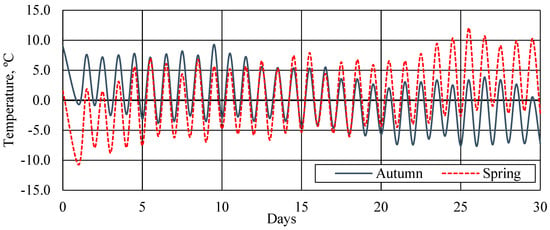
Figure 2.
Daily temperature changes in Autumn (8 of October to 7 of November of 2019) and spring (20 of March to 19 of April of 2020), UB.
Therefore, special attention should be paid to concrete works in Mongolia, not only during the harsh winter season, but also during the spring and autumn seasons. It is important to protect the concrete not only from the early age freezing, but also to prevent damages by freezing and thawing cycles.
2.2. Construction Sites
Recently, construction companies have begun to strive for continuous construction work during winter seasons in Mongolia. However, in a market society, it is necessary to develop detailed guidelines and technological procedures for the timing of concrete pouring in the cold season due to the financial policies of construction companies and the extreme weather conditions in Mongolia. If the freezing of the concrete begins, especially before the cement hydration is not completed, the final concrete strength decreases, and the designed strength could not be achieved. Degradation of the concrete strength also leads to low durability of concrete structures. However, after the transition of construction methodology from pre-cast concrete technology to cast-in-place concrete technology, there is a lack of a unified methodology for performing the necessary procedures such as curing, reinforcing, and controlling during the winter season. Therefore, it is common for concrete works to be done even in the winter without prior planning. Some sceneries of cold weather construction sites are shown in Figure 3, Figure 4 and Figure 5.
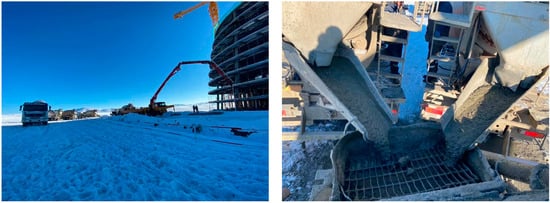
Figure 3.
Construction site in December 2020 (average temperature was −17.7 °C).

Figure 4.
Frozen concrete structure of apartment building in November 2019 (average temperature was −9.6 °C).

Figure 5.
Concrete work of foundation executed in December 2019 (outside temperature was −34.6 °C).
It has been reported that in the first ten days of November 2019, concrete was poured in more than 120 buildings in the construction sites in UB []. As it reported, construction companies had not taken anti-freezing measures in construction sites such as heat curing, covering with thermal insulation materials etc. in most of the cases. Figure 4 shows that a frozen reinforced concrete structure which executed in November 2019. In general, this kind of construction works has been completed without any treatment after frost exposure in Mongolia. Therefore, it is difficult to control the quality of concrete without changing the existing norms and regulations especially for the newly constructed buildings executed in cold seasons.
The State Specialized Inspection Agency of Mongolia (SSIAM) has often issued the commands for stopping pouring the concrete [,], when daily average temperature drops below +5 °C and daytime temperatures do not exceed 0 °C, according to existing Mongolian norms since most of the existing concrete structures and load-bearing frames which are executed in cold season do not reach the target strength. Thereby SSIAM wants to prevent from accidents at construction sites and to ensure the target strength of concrete during the winter season. Concrete works have not been completely stopped during the cold season even outside temperature is −34.6 °C in mid-winter season as shown in Figure 5.
2.3. Cement Suppliers
Cement is one of the most important raw materials in the concrete industry. If the quality of cement and cement production activities are not stable, it will not be possible to keep sustainable production of concrete. Currently, there are four main cement plants in Mongolia with a total capacity of four million tons of cement per year. However, 82% of the total cement consumption is used in six months from May to October due to the climatic conditions of Mongolia. Therefore, cement consumption increases sharply during the summer months, as shown in Figure 6 [], due to construction works usually carried out in summer. Due to this, there are constant negative consequences such as overloading of cement production, rising of the cement prices, and shortage of transportation and logistics during the summer season.

Figure 6.
Annual cement consumption of Mongolia in 2020.
However, it is difficult to maintain the stability of the cement production and the stability of the workforce during winter season in Mongolia. Therefore, establishing the appropriate guidelines for cold weather concrete works can extend the workable period and it will help to stabilize cement production and demand.
2.4. Labor Demand
According to the Labor Demand Survey in 2019, 69.4 thousand jobs had been created in Mongolia, of which 25.5 percent was in the construction sector []. This is the highest rate compared to other sectors as shown in Figure 7. On the other hand, the survey revealed that seasonality has influenced on annual labor-force demand. According to the average of the last 6 years’ survey, more than 75 percent of labor-force demand occurs in the first half of a year as shown in Figure 8. In recent years, this trend has been on the rise, with more than 80% of the workforce expected to occur by the first half of 2020.
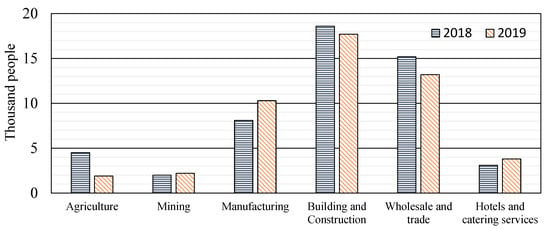
Figure 7.
Labor demand by sector.
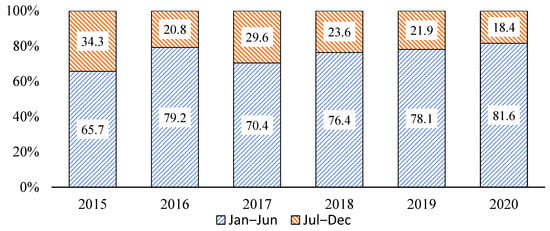
Figure 8.
Labor-force demand, by time and percent.
From the above information, it can be seen that the construction industry is seasonal due to the extreme weather conditions in Mongolia, which creates instability not only in the construction sector, but also socioeconomic situation in Mongolia. Construction is booming in the summer months and the construction sector is creating a lot of temporary jobs, which has a positive impact on socioeconomic life. However, unemployment is rising due to the stagnation of construction during the cold season.
Therefore, if it is possible to extend the time of concrete work by developing possible methods and guidelines for pouring continuously during the cold season, it will help to stabilize the construction workforce and reduce seasonal unemployment to some extent.
3. Existing Norms and Regulations
Mongolia has no separate cold weather guidelines. Instructions for cold weather concreting are included in chapter 9 of BNbD52-02-05 (Cast Concrete and Reinforced Concrete Structures) [], which is adopted in 2005 as a guideline for concrete in general. To evaluate the current Mongolian norms and regulations (BNbD52-02-05) for the cold weather concreting, a comparison was made with two international norms. The first one is the American Concrete Institute (ACI) Report ACI 306 R-16, which is the most popular in the world. Second is the Architectural Institute of Japan (AIJ) guidelines for recommendation for practice of cold weather concreting.
ACI 306 R-16 [] considered that cold weather exists when the air temperature is/will be below 4 °C during the protection period. The protection period is defined as the time to prevent concrete from being adversely affected by exposure to cold weather during construction. ACI’s protection period recommendations are mainly based on the concept of maturity that the combination of curing time and temperature of the concrete, which is originally defined by Saul in 1951 []. Saul formulated the rule of strength gain with maturity as follows: “concrete of the same mix at the same maturity has approximately the same strength whatever combination of temperature and time go make up that maturity.” This one-to-one relationship makes it possible to develop formulas for the estimation of concrete strength from the values of maturity.
Architectural Institute of Japan (AIJ) also has a guideline with two aspects, based on the frost damage at the beginning stage and maturity []. First, the period to prevent initial freeze damage is defined as the period when the average daily temperature is 4 °C or less including the casting date. Second, the period of delay in strength development due to low temperature and curing conditions are considered. The period when the accumulated temperature M91 is less than 840 degree-days (°D·D) up to 91 days after the concrete is placed is also defined as cold weather. The second criterion is especially important for continuous building work during the winter season.
Table 1 shows the comparison of Mongolian norms with ACI and AIJ guidelines. The current Mongolian norms and regulations for cast concrete and reinforced concrete structures (BNbD52-02-05) are not only describing the cold weather concreting, but also describe many other subjects for the cast-in-place concrete and reinforced concrete structures. Only chapter 9 briefly explains cold weather concreting. Therefore, current construction norms do not fully cover the country’s long cold seasons since important specifications and definitions are not adequate.

Table 1.
Comparison of cold weather guidelines.
Table 2 shows a translation of the chapter 9 of BNbD52-02-05. There are some subjects addressed in this norm. However, this norm does not clearly explain appropriate methodologies for the cold weather concreting. For instance, it is not clear that how to prepare the work execution program (WEP) and technological card (TC) when executing concrete works during the winter season as required by article 9.2 of the existing norm. ACI guidelines describe the temperature requirements for the cold weather concreting depend on ambient air temperature. As indicated in ACI guidelines, the rate of heat loss increases as the temperature differential between the concrete and ambient temperature increases. Therefore, using concrete with a higher temperature does not improve the protection against freezing due to higher temperatures require more mixing water, increase the rate of slump loss, can cause quick setting, and increase thermal contraction []. However, existing Mongolian norms do not completely describe the temperature requirements for the cold weather concreting. Therefore, it is necessary to include the detailed temperature requirements and its calculation methods in existing Mongolian norms.

Table 2.
A translation of the individual articles of chapter 9 of BNbD52-02-05.
Table 3 shows that curing recommendations and methods described in the attachment 4 of article 9.6 of Mongolian norms. As indicated in this recommendations, concrete work can be executed even temperature is below −25 to −40 °C using the specific methods for the cold weather concreting, such as heating molds, covering with heated coating and cold weather admixtures. However, there is no sufficient information to execute the actual work in the construction site due to specific technical requirements and detailed methodologies are not described in the norms. On the other hand, curing is most important for cold weather concreting. As indicated in AIJ guidelines, the curing method, curing period and planned curing temperature should be determined separately from the initial curing with the aim of obtaining the necessary strength at the planned age []. Therefore, several curing methods and its descriptions are included in AIJ guidelines such as initial curing, heat curing, insulation curing, covered curing, etc. It is recommended to include this kind of detailed descriptions in existing Mongolian norms.

Table 3.
The curing recommendations and methods.
4. Outline of Questionnaire Survey and Interview with Mongolian Companies
The authors conducted a questionnaire survey accompanied with interviews on cold weather concreting in UB in 2020. The description of respondents is given in Table 4. Seventeen responses were collected from specialists, general engineers, and directors who have experience with cold weather concreting. They are employees of construction companies, ready-mixed concrete companies, precast concrete companies, consultants, and governmental entities.

Table 4.
Description of respondents.
The questionnaire consisted of 10 open-ended, closed-ended, and multiple-choice questions, which were uniquely prepared by the authors was used in this survey. The list of questions is given in Table 5. The priority has been given to make certain of the following matters: (1) sufficiency of Mongolian norms for cold weather concreting, (2) whether they execute concrete work during the winter, (3) definition of the border of the cold season for concreting, and (4) what items should be included in the Mongolian norms.

Table 5.
The list of questions.
5. Results and Discussion
5.1. Sufficiency of Mongolian Norms
All companies are referring to the Mongolian norms and regulations for the cold weather concreting. However, 53% of them thought that current Mongolian norms and regulations are not sufficient for the cold weather concreting (Figure 9). Therefore, they seemed reluctant to follow the norms. On the other hand, the answers from non-governmental and government entities have insisted that the quality of concrete cannot be controlled during winter season same as other seasons (Figure 10). Therefore, government entities are not allowed to execute concrete works during winter season due to the reasons of durability of cold weather concrete is uncertain and strength development is very much depended on ambient temperature. Only one ready-mixed concrete company invested in by a foreign country has answered that they are using the international norms. In addition, a non-governmental entity also answered that they were using the Canadian norms when work on the Oyu Tolgoi project, which is the biggest copper mining project in Mongolia. All other companies were referring the Mongolian norms (Figure 11).
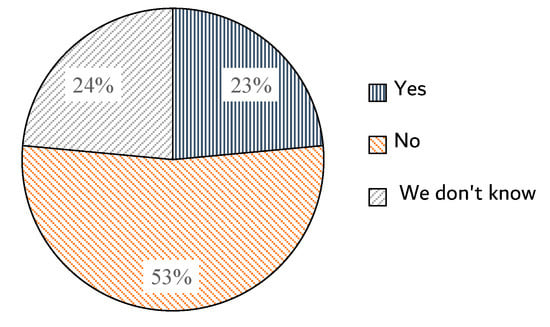
Figure 9.
Do Mongolian norms sufficient for the cold weather concreting?
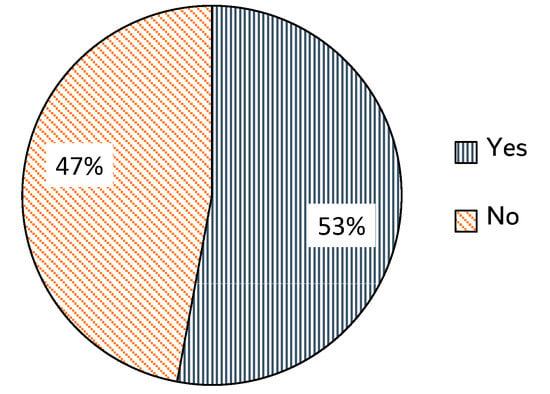
Figure 10.
Can quality of concrete be controlled same as the other seasons during winter season?

Figure 11.
What standard do you use for cold weather concreting?
5.2. Whether They Execute Concrete Work during the Winter
Although the Mongolian norms are recognized as insufficient according to the abovementioned results, most of the construction companies and ready-mixed concrete companies answered that quality of concrete can be controlled same as the other seasons during winter season. Therefore, 71% of respondents answered that they execute concrete work during winter season (Figure 12).
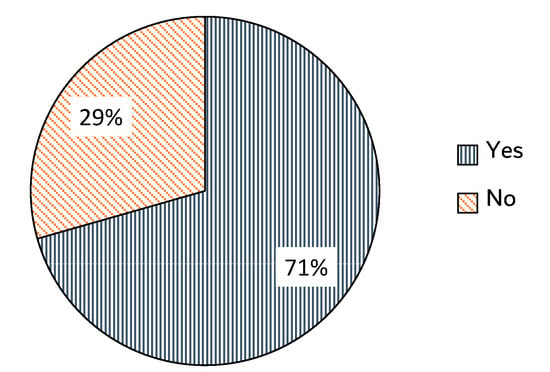
Figure 12.
Do you execute concrete works during winter season?
The main reason for executing concrete works during the winter season is that available construction time in Mongolia is extremely short and construction work could not be finished as scheduled (Figure 13). On the other hand, one of the construction companies explained that construction works can be done in early spring or late autumn. They use concrete with winter admixture, and then make covering and heat up until 3 days from the casting when executing the concrete works in the cold season. However, they did not explain why they cure concrete for 3 days and what kind of chemical additives are used in winter.
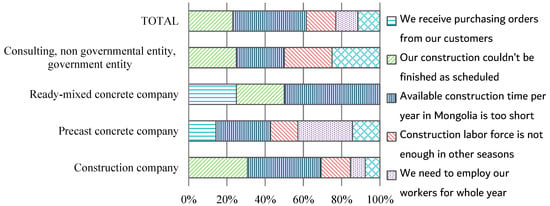
Figure 13.
Why execute concrete works during the winter season?
If the construction site is well prepared, planned, and inspected properly, it will be possible to execute concrete works for a certain period of time during the winter as responded by a non-governmental entity. However, as shown in Figure 14, most of the respondents are monitoring the concrete temperatures and weather forecast, but only a few of them care about the special curing and/or appropriate additives during the winter season.
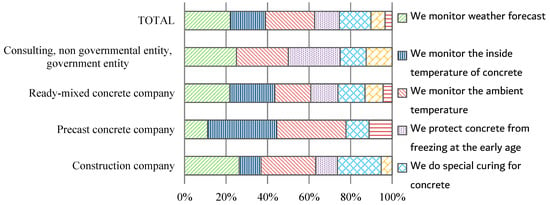
Figure 14.
What are the following things you do during cold weather concreting? (Allowed multiple answers).
5.3. Definition of Border of the Cold Season for Concreting
According to the current Mongolian norms, the cold season is recognized when daily average temperature is below 5 °C and daytime temperatures do not exceed 0 °C. Therefore, cold season can be continued from the end of September to end of April. The long duration of cold season is impractical in actual situation and many companies are faced with problems in following the existing norms. However, most of the respondents continue the concrete works until middle of November or until the lowest temperature reaches −20 °C, without taking appropriate countermeasures for the cold weather concreting (Figure 15). Therefore, it is desirable to define a more appropriate time limit for the Mongolian situation to determine the application period of cold weather concreting; likewise, AIJ defines the average temperature and the accumulated temperature based on maturity.
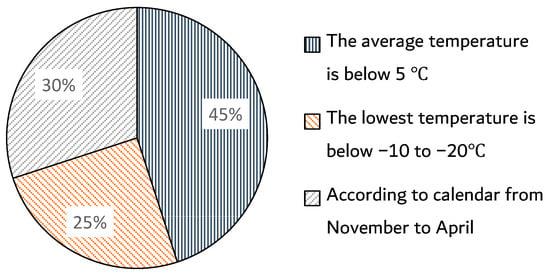
Figure 15.
How do you decide start and end of the winter season?
5.4. What Items Should Be Included in Mongolian Norms
As mentioned by respondents, current Mongolian norms and regulations are not sufficient for the cold weather concreting due to lack of detailed methodological guidelines and rules in the existing norms. Additionally, they mentioned that the necessity of establishing a new national norm adapting the norms of cold countries, such as Japan, Russia, America, etc. The respondents noted that following items should be considered in the new national norms.
- Detailed methodology for the quality control when execute concrete works during the winter season;
- Any new methodologies which can protect concrete from freezing, thereby construction work can be continued in cold seasons. For example, proper way to using a protecting cover, proper way to using internal and external heating, using admixtures etc., have been pointed out;
- Possible method to use the architectural hybrid systems combined with prefabricated concrete elements.
6. Conclusions
Following conclusions can be drawn from this investigation.
- Due to the climatic conditions of Mongolia, the available time for concrete work is extremely short. Therefore, construction companies often execute the concrete work in the cold season. It is anticipated that the strength of concrete does not reach to the target strength and low-quality buildings are often built;
- This study shows that continuation of construction in cold seasons is important in reducing seasonal unemployment;
- Mongolian temperature fluctuations are very high in spring and autumn. As a result, many freeze–thaw cycles can occur during the casting and the strengthening of concrete structures;
- All respondents insisted that there is an insufficiency in consensual Mongolian norms for cold weather concreting due to lack of detailed methodological guidelines and rules in the existing norms;
- This survey revealed that there is a large inconsistency among the stakeholders when defining the border of the cold season for concreting. However, the survey revealed that the construction works are executed at temperatures between −10 °C and −20 °C, without taking appropriate actions which should be taken for concreting in cold weather.
Author Contributions
Conceptualization, B.N., T.N. and D.P.; methodology, B.N.; validation, T.N. and D.P.; formal analysis, B.N.; investigation, B.N.; data curation, B.N.; writing—original draft preparation, B.N.; writing—review and editing, T.N. and D.P.; visualization, D.P.; supervision, T.N.; project administration, T.N.; All authors have read and agreed to the published version of the manuscript.
Funding
This research received no external funding.
Institutional Review Board Statement
This study did not require ethical approval.
Informed Consent Statement
Informed consent was obtained from all subjects involved in the study.
Data Availability Statement
Not applicable.
Acknowledgments
The authors would like to sincerely appreciate the respondents of the questionnaire survey for their detailed suggestions and explanation of actual problems. The advice from Madoka Taniguchi, Hokkaido Research Organization, Japan, is gratefully acknowledged. This research did not receive any specific grant from funding agencies in the public, commercial, or not-for-profit sectors.
Conflicts of Interest
The authors declare no conflict of interest.
Appendix A

Table A1.
General specifications for winter concrete (Table 10 in BNbD52-02-05 shown in Table 2).
Table A1.
General specifications for winter concrete (Table 10 in BNbD52-02-05 shown in Table 2).
| No | Characteristics | Amount | Testing Method |
|---|---|---|---|
| 1 | 2 | 3 | 4 |
| 1 | Cast-in place and precast
From B7.5 (M100) to B10 (M150) From B12.5 (M179) to B25 (M350) B30 (M400) or higher
| Not less than 5 MPa Should be obtained following percent of design strength: 50 40 30 70 80 Add chemical additives until obtain 20 percent of the design strength before freeze | It should be written on the work record sheets according to MNS 1272:99. Concrete strength shall be tested according to MNS1920:99; MNS3322:91; MNS 3323:91; MNS 4113:91 |
| 2 | Required strength for applying load to structure | 100% of design strength | |
| 3 | Water and concrete mixture temperatures after mixing:
| Water and mixture temperature shall not exceed 70 °C and 30 °C, respectively. Water and mixture temperature shall not exceed 60 and 30 °C, respectively. Water and mixture temperature shall not exceed 40 and 25 °C, respectively. | Measure and record in work records sheet twice per shift. |
| 4 | Concrete temperature after pouring into mold, when starting heating:
| To be decided by technological calculations, but not less than 5 °C. Should be more than 5 °C from concrete freezing temperature | To be measured at locations specified in WEP and TC and it should be written on the work record sheets. |
| 5 | Temperature requirements for the heat treatment:
| To be determined by technological calculations, but cannot exceed the following °C: 80 90 | To be measured every 2 h on the first day. Not less than twice per shift for the following 3 days and after heating is stopped. To be measured daily afterwards. |
| 6 | Temperature increasing speed during the heat treatment:
5 to 10 10 or more joint concrete | No more than the following °C per hour: 5 10 15 20 | To be measured every 2 h and it should be written on the work record sheets. |
| 7 | Temperature decreasing after heat treatment:
5 to 10 10 or more | By technological calculation No more than 5 °C/h No more than 10 °C/h | To be measured every 2 h and it should be written on the work record sheets. |
| 8 | Temperature difference between structure surface and environment air, when reinforcement coefficient is 1 to 3 or more than 3:
5 or more | No more than 20, 30, 40 °C No more than 30, 40, 50 °C | To be measured every 2 h and it should be written on the work record sheets. |
Note: The layout of the table is in accordance with existing document and translated to English by the authors.
References
- The Coldest Capital Cities in the World. Available online: https://www.worldatlas.com/articles/the-coldest-capital-cities-in-the-world.html (accessed on 17 June 2022).
- Sang, Y.; Yang, Y. Assessing the Freezing Process of Early Age Concrete by Resistivity Method. Constr. Build. Mater. 2020, 238, 117689. [Google Scholar] [CrossRef]
- Nassif, A.Y.; Petrou, M.F. Influence of Cold Weather during Casting and Curing on the Stiffness and Strength of Concrete. Constr. Build. Mater. 2013, 44, 161–167. [Google Scholar] [CrossRef]
- Bai, S.; Guan, X.; Li, G. Effect of the Early-Age Frost Damage and Nano-SiO2 Modification on the Properties of Portland Cement Paste. Constr. Build. Mater. 2020, 262, 120098. [Google Scholar] [CrossRef]
- Qin, L.; Gao, X.; Zhang, A. Potential Application of Portland Cement-Calcium Sulfoaluminate Cement Blends to Avoid Early Age Frost Damage. Constr. Build. Mater. 2018, 190, 363–372. [Google Scholar] [CrossRef]
- Yi, S.-T.; Pae, S.-W.; Kim, J.-K. Minimum Curing Time Prediction of Early-Age Concrete to Prevent Frost Damage. Constr. Build. Mater. 2011, 25, 1439–1449. [Google Scholar] [CrossRef]
- Wan, B.; Chakraborty, S.; Kim, H. Data in Brief Prediction of the Curing Time to Achieve Maturity of the Nano-Cement Based Concrete Using the Weibull Distribution Model: A Complementary Data Set. Data Brief 2015, 4, 285–291. [Google Scholar] [CrossRef][Green Version]
- Choi, H.; Hama, Y.; Taniguchi, M. Maturity and Strength Development of Mortar with Antifreezing Admixture at Temperatures Lower than 0 °C. Materials 2019, 12, 3172. [Google Scholar] [CrossRef] [PubMed]
- Karagol, F.; Demirboga, R.; Khushefati, W.H. Behavior of Fresh and Hardened Concretes with Antifreeze Admixtures in Deep-Freeze Low Temperatures and Exterior Winter Conditions. Constr. Build. Mater. 2015, 76, 388–395. [Google Scholar] [CrossRef]
- Svintsov, A.P.; Shchesnyak, E.L.; Galishnikova, V.V.; Fediuk, R.S.; Stashevskaya, N.A. Effect of Nano-Modified Additives on Properties of Concrete Mixtures during Winter Season. Constr. Build. Mater. 2020, 237, 117527. [Google Scholar] [CrossRef]
- Zhang, G.; Yang, Y.; Li, H. Calcium-Silicate-Hydrate Seeds as an Accelerator for Saving Energy in Cold Weather Concreting. Constr. Build. Mater. 2020, 264, 120191. [Google Scholar] [CrossRef]
- Won, J.Y.; Lee, S.H.; Park, T.W.; Nam, K.Y. Basic Applicability of an Insulated Gang Form for Concrete Building Construction in Cold Weather. Constr. Build. Mater. 2016, 125, 458–464. [Google Scholar] [CrossRef]
- Alzaza, A.; Ohenoja, K.; Illikainen, M. Enhancing the Mechanical and Durability Properties of Subzero-Cured One-Part Alkali-Activated Blast Furnace Slag Mortar by Using Submicron Metallurgical Residue as an Additive. Cem. Concr. Compos. 2021, 122, 104128. [Google Scholar] [CrossRef]
- Zhang, G.; Yang, H.; Ju, C.; Yang, Y. Novel Selection of Environment-Friendly Cementitious Materials for Winter Construction: Alkali-Activated Slag/Portland Cement. J. Clean. Prod. 2020, 258, 120592. [Google Scholar] [CrossRef]
- Pushpalal, D.; Danzandorj, S.; Bayarjavkhlan, N.; Nishiwaki, T.; Yamamoto, K. Compressive Strength Development and Durability Properties of High-Calcium Fly Ash Incorporated Concrete in Extremely Cold Weather. Constr. Build. Mater. 2022, 316, 125801. [Google Scholar] [CrossRef]
- The Research Institute of Labor and Social Protection. Report of Barometer Survey on Labor Market Demand; The Research Institute of Labor and Social Protection: Ulaanbaatar, Mongolia, 2019. [Google Scholar]
- Geography of Mongolia. Available online: https://en.wikipedia.org/wiki/Geography_of_Mongolia (accessed on 12 June 2022).
- Ulaanbaatar Climate & Temperature. Available online: https://www.namem.gov.mn/ (accessed on 5 July 2022). (In Mongolian)
- Construction and Concrete Pouring are Prohibited during the Cold Season. Available online: https://about.barilga.mn/n/10576/ (accessed on 13 June 2022). (In Mongolian).
- Concrete Work is Prohibited in the Cold Season. State Specialized Inspection Agency of Mongolia. Available online: https://zasag.mn/news/view/12085 (accessed on 2 June 2022). (In Mongolian).
- Minister of Construction and Urban Development Kh. Badelkhan Official Assignment. Available online: https://mcud.gov.mn/a/468 (accessed on 2 June 2022).
- Mongolian Statistical Informaion Service. Available online: http://www.1212.mn/stat.aspx?LIST_ID=976_L11 (accessed on 17 May 2022).
- Ministry of Construction and Urban Development of Mongolia. Construction Norms and Regulations of Mongolia, BNbD 52-02-05 Cast Concrete and Reinforced Concrete Structure; Ministry of Construction and Urban Development of Mongolia: Ulaanbaatar, Mongolia, 2005. [Google Scholar]
- ACI (306R-16); Guide to Cold Weather Concreting. American Concrete Institute: Farmington Hills, MI, America, 2016.
- Popovics, S. Strength and Related Properties of Concrete: A Quantitative Approach; John Wiley & Sons: Hoboken, NJ, USA, 1998; p. 12. [Google Scholar]
- Architectural Institute of Japan. Recommendation for Practice of Cold Weather Concreting; Architectural Institute of Japan: Tokyo, Japan, 2010. [Google Scholar]
Publisher’s Note: MDPI stays neutral with regard to jurisdictional claims in published maps and institutional affiliations. |
© 2022 by the authors. Licensee MDPI, Basel, Switzerland. This article is an open access article distributed under the terms and conditions of the Creative Commons Attribution (CC BY) license (https://creativecommons.org/licenses/by/4.0/).